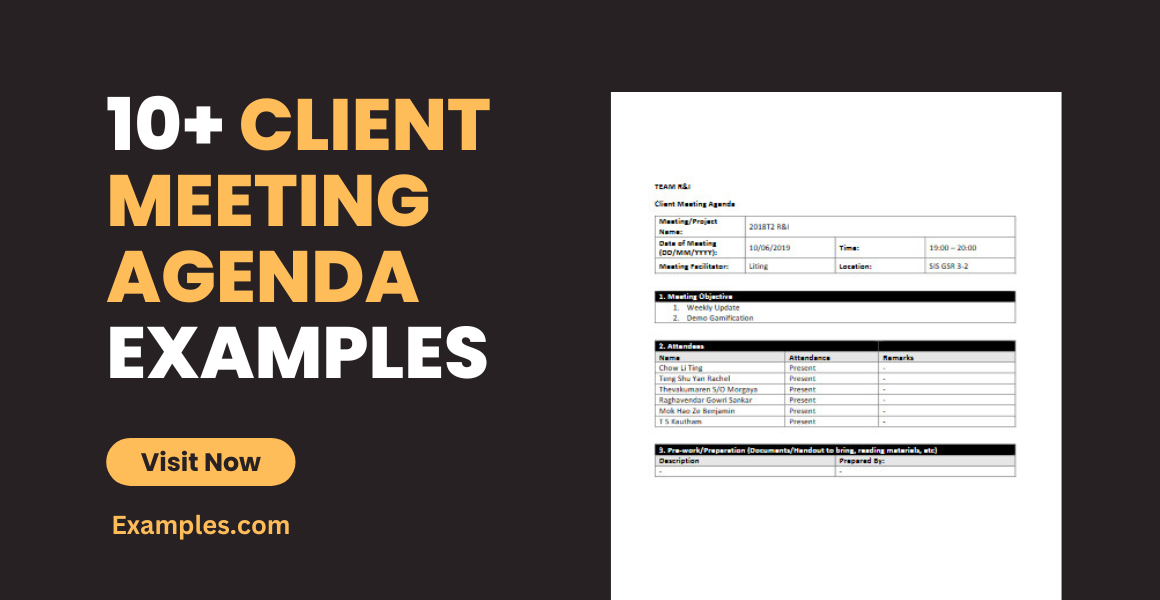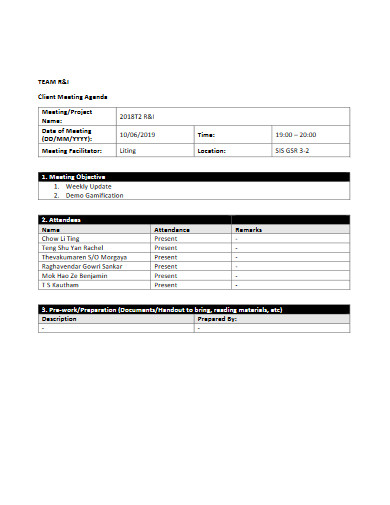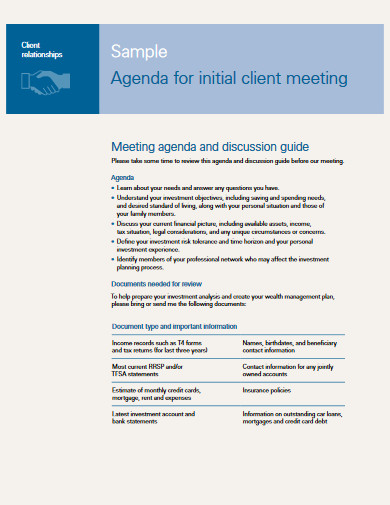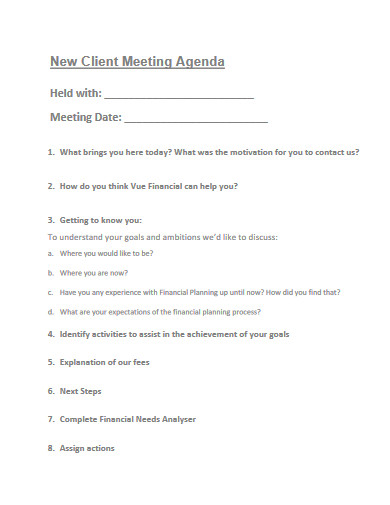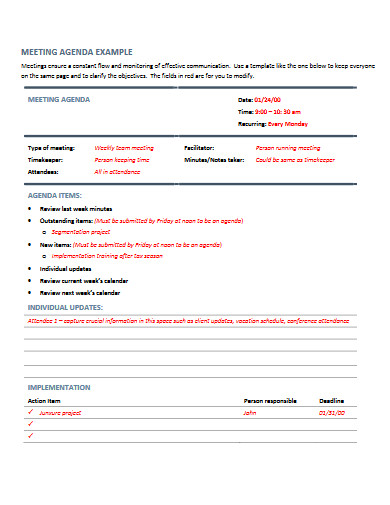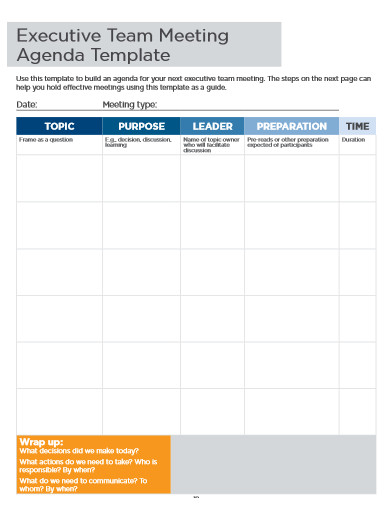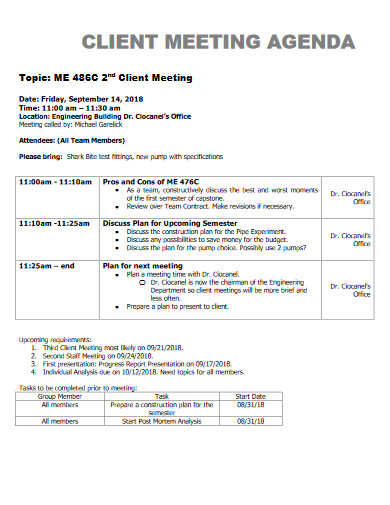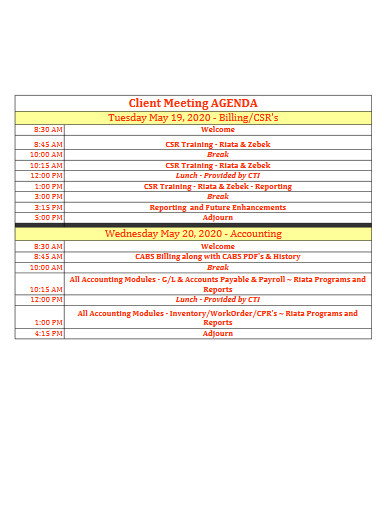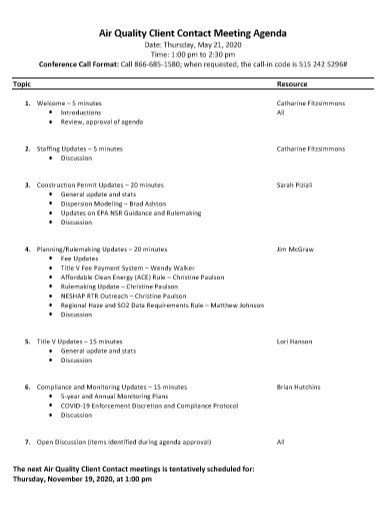10+ Client Meeting Agenda Examples to Download
If you shiver in front of your colleagues when presenting a team meeting agenda, double that nerve-wracking experience when you attend an interest meeting with an unknown client. It’s easy to think that it’d be difficult, but when you’ve thoroughly prepared for that session, there’s nothing to be worried about. Slay your presentation and get customers to your side with an efficient client meeting agenda. This doesn’t only help you identify the significant points of your discussion, but this also creates the session’s flow. This is also a great way to customize your topic according to your client’s needs. Learn more about this through the article below.
10+ Client Meeting Agenda Examples
1. Client Meeting Agenda
2. Technology Client Name Meeting Agenda
3. Agenda for Initial Client Meeting
4. Client Advisory Committee Meeting Agenda
5. New Client Meeting Agenda
6. Client Name Meeting Agenda
7. Client Meeting Agenda Example
8. Executive Team Client Meeting Agenda Template
9. Client Meeting Agenda in PDF
10. Sample Client Meeting Agenda
11. Client Contract Meeting Agenda
What Is a Client Meeting Agenda?
A client meeting agenda is a list of activities and topic discussions during a session with a customer or a client. This is an important presentation preparation tool for industries that offer services such as direct selling, consulting, and outsourcing. This ensures that you’ll cover the essential topics within the given time frame without getting sidetracked with unimportant details. This also helps businesses ensure that they’ll model their agenda topics after their client’s needs and objectives.
Must-Dos During Client Meetings
According to Doodle’s The State of Meeting Report for 2019, the cost unproductive meetings will cost US companies $399 billion and while the UK may lose $58 billion. This statistics feature in Inc shows how getting strapped in a conference room for hours or even minutes with no real development can hurt your employee’s productivity and your business’s state. An office setting is a different issue. How about meeting a client with pointless discussions? You will lose not only a potential customer but also your reputation in holding good business deals.
Here are some must-dos to ensure that your meeting’s every second count:
1. Do come prepared. You will want to answer your client questions with ease and expertise.
2. Do remember your client’s name. It’s impressive to them when you take the time to know them prior to the meeting.
3. Do arrive on the right time according to schedule.
4. Do remain professional. You can be friendly to converse comfortably but avoid colloquial terms and touchy gestures.
5. Do avoid criticizing your client’s competitor. You may want to win your client’s approval but never talk ill about its opposing business. You never know, that might be your next client.
How to Prepare a Client Meeting Agenda
Planning meetings that are focused and goal-oriented can be challenging. If you’re looking for a way to organize your agenda, skim through the following tips:
1. Level with Your Client’s Goal
Office meetings with subordinates and co-employees have defined agendas that everyone needs to adapt to in their discussion. However, client meetings are different. Instead of focusing on your goal as a business person, a representative, or a consultant, the best thing to do is to put your client’s needs first. This allows you to relay information that your client can relate to. For example, if you’re client is looking for new materials to complete their construction project, allow them to express their objectives and what product specifications will satisfy their goals. Then, you’ll be able to offer options based on what they’ve shared.
2. Know Your Client Beforehand
This can be hard, especially when holding impromptu customer visit meetings. When this happens, poring a bit into your client’s background with questions about their business, line of work, and objectives can be helpful. However, if you’re expecting a client at a given date and time and have already sent out the meeting invitation, do client research. If you’re catering to fellow businesses, check their business profile and their latest works. It the client is a freelancing professional, check his or her work. Doing this helps you offer more products and services that better suit both their short-term and long-term goals.
3. Avoid Overloading
Remember that your clients have limited time to spare. They won’t like it if you confine them to a single meeting that lasts for hours. While you may want to hold longer sessions in hopes of productive development, this may result in the opposite. If you want to shorten your meeting schedule and cover an ample amount of topics in a short period, send the details beforehand. If it includes lengthy reports, submit the necessary documents for advance review. This saves you a lot of time during the actual discussion because you’ll only be reviewing the highlights and your client’s clarifications. Prepare a business presentation that’s summarized, explained in plain words, and includes charts and illustrations, so it’s easy to comprehend.
4. Talk Less, Listen More
Increase your client’s engagement throughout the session by asking questions, encouraging suggestions, and soliciting feedback. As you allow your client to contribute more to the discussion, you’ll have more opportunities to understand their needs and address them. Never let all the talk come from you by merely explaining the points behind your meeting agenda list. The meeting should never be about you in the first place but to provide action plans and solutions to your client’s challenges.
5. Provide a Summary
You’ll never realize how important it is to ensure that your client understands your discussion’s main points at the end of the session. An effective way to do this is to provide a summary of your entire agenda. Create an outline with your topics as the headline and list down all the significant points under it. You should also include a detailed list of your client’s inquiries and the answers to each of them for review. This is why it’s important to take notes on the minutes of the meeting, so you don’t miss out on all of these. This is an efficient way to wrap up your discussion.
FAQs
What should you include in a meeting agenda?
When making a meeting agenda, here are some things that you must include:
- Meeting schedule (time, date, and location)
- List of participants
- List of topics for discussion
- Overall objectives of the meeting
What are some of the best locations to meet clients?
According to Inc, the top five best places to meet clients are coffee shops, museums, hotels, libraries, and restaurants.
What are the different types of meetings?
The types of meetings vary according to their discussion purpose. They are as follows:
- Information sharing meetings
- Decision-making meetings
- Team building meeting
- Status update meetings
- Innovation meetings
Client meetings can be intimidating. While the goal might be to prioritize your client’s needs before addressing your own, there’s still an underlying pressure to get them to sign with an agreement with you. After all, it’s business. With the right meeting plan, you’ll be able to accomplish your client’s objectives while also fulfilling yours. Do that with our client meeting agenda templates. They are ready-made with the right parts to help you prepare the best. Download now!


